Madhava Nidana Chapter 12 Hikka Shwasa Nidanam
This article explains Madava nidaana 12th chapter “Hikka Shwasa Nidanam”. Causes, pathology and symptoms of Hikka and Shwasa are explained in this chapter.
Read – Acharya Madhavakara: His Work ‘Madhava Nidana’, Legacy, Amazing Facts
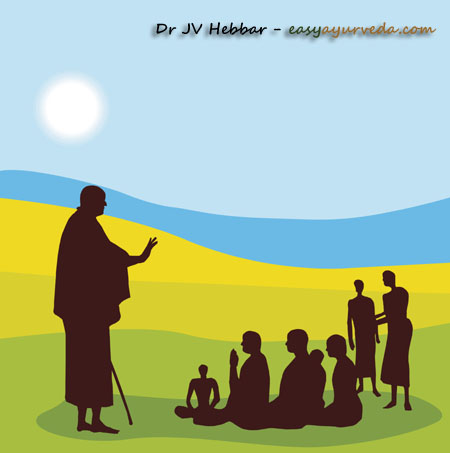
Table of Contents
Hikka Swasa Nidanam
Etiological factors of hiccough and dyspnoea
Excessive indulgence in foods which are corrosive (produce heartburn), heavy (difficult to digest), which could cause constipation, dry in nature and which cause blockages in the pores of the tissues or channels of transportation,
Excessive consumption of very cold water (or other beverages) and foods,
Starvation,
Living in cold places
Exposure to dust, smoke, sunlight and breeze,
Excessive physical exercise / exertion
Indulgence in activities beyond one’s capacity,
Lifting or carrying heavy weights,
Walking long distances,
Suppression of natural urges and
Malnutrition
The person who indulges in the above-mentioned etiological factors becomes victim of hikkā (hiccough), śwāsa (dyspnoea / difficult respiration) and kasa (cough).(1-2)
Read – Charaka Hikka Shwasa Chikitsa 17th Chapter
Definition/Meaning of Hikka
The aggravated Vāyu (udana along with prana vata) comes out of the mouth with immense velocity (speed), repeatedly, as if throwing the liver, spleen and intestines out of the mouth (the patient feels as if these organs are coming out of the mouth), it produces hik-hik sounds. Making the sounds in this way the vayu tends to cause harm to the life in quick time. Wise physicians call this disease as hikka (compared to hiccough). (3)
Read – Hiccups Causes, Remedies, Types, Symptoms, Ayurvedic Treatment
Types of Hikka
Vāta associated with kapha produces hikkā. This hikka is of 5 types, they are –
- Annajā hikka
- Yamalā hikka
- Kshudrā hikka
- Gambhīrā hikka and
- Mahatī hikka (4)
Hikka Purvarupa
Premonitory symptoms of Hikka
Premonitory symptoms of hikkā are heaviness of throat and chest, astringent taste in the mouth and gurgling noise in the abdomen. (5)
Annaja Hikka
This type of hikka is caused by excessive consumption of foods and drinks too quickly. Such foods and drinks taken in excess immediately impart pressure on vata. Thus, vata gets aggravated and moves in upward direction and causes hikka. Such a hikka caused by anna (foods and drinks) is called as Annajā hikkā. (6)
Read – Symptoms Of Vata Dosha Increase And Imbalance – Vata Vruddhi Lakshana
Yamala Hikka
Yamala means two. Yamalā hikkā (its bouts) occur in pairs.
The hikka which occurs while causing shaking of head and neck, continues for a long time (repeatedly occurs, after breaks, intermittently) and occurs in pairs (produces two sounds of hik at a time, one after the other) is called Yamala hikka.(7)
Kshudra Hikka
Kshudrā hikkā is that which occurs occasionally (after long gaps), whose bouts are mild in intensity, and starts only from the base of the neck (junction of neck and chest). (8)
Gambhira Hikka
Gambhirā hikkā, which starts from deep inside the umbilicus, is very powerful, makes heavy sound and is accompanied with many complications. (9)
Maha Hikka
Mahāhikkā is that which produces powerful feeling as though all the vital organs are being pulled out of the body, continuously persists without giving a break, and causes tremors / shaking of the whole body.(10)
Read – Hikka Nigrahana Gana – Anti Hiccup Herb Group Of Charaka – Review
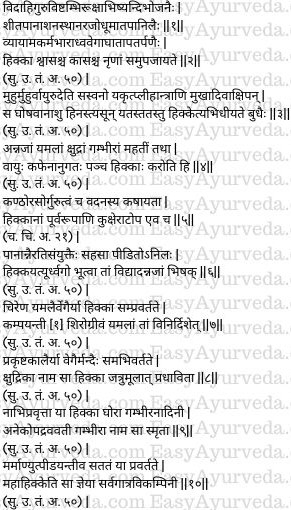
Read – Ayurvedic Home Remedy For Hiccup
Symptoms of incurability of Hikka
Patients of hikkā who have developed excessive stretching of the entire body, has gaze fixed in upward direction (or gets constricted) and the body always bent, is emaciated, has aversion towards food, has many bouts of sneezing and who has the last two types of hikka i.e., gambhira and mahati. These people shall be refused treatment (because this condition is incurable). (11)
The patient of hikka will succumb to death in quick time when there is excessive increase of all the doshas, he is unable to take food and hence has become emaciated, has become weak and debilitated as an effect of long-standing diseases, is aged, indulged in excessive sexual intercourse, who has yamala type of hikka, has delirium, pain, delusion and severe thirst. (12-13)
Yamalā hikkā is curable in those who are not emaciated (physically strong), who have strong mind, whose tissues and senses are good (and in a state of health), whereas it kills others (those who are weak physically and mentally, whose tissues and senses are not in a good state of health).(14)
Read – Why You Should Not Suppress Sneezing: Effect, Treatment
Types of Swasa (dyspnoea)
Swasa which is counted as a mahāvyādhi (powerful disease) is a single entity (disease). But based on the different forms of its manifestation and on the basis of different kinds of etiological factors and symptoms swasa is mentioned to be of five kinds.
The five kinds of swasa are –
Mahatī Swasa
Urdhwa Swasa
Chinna Swasa
Tamaka Swasa and
Kshudra Swasa (15)
Dosha relationship with different kinds of swasa
In Kshudra Swasa – vata is predominant (vataja)
In Tamaka Swasa – kapha is predominant (kaphaja)
In Chinna Swasa – Kapha and Vata are predominant (kapha-vataja)
In Mahat and Urdhva Swasa – Vata is predominant (vataja)
(Along with these, the other doshas are also associated – pitta)
Read – Shwasa Roga – Dyspnoea: Types, Symptoms As Per Ayurveda
Swasa Purvarupa
Premonitory symptoms of dyspnoea
The premonitory symptoms of Swasa are – pain in the region of the heart, abdominal colic and distension (tympanitis) and enlargement of abdomen / flatulence, bad taste in the mouth and pricking (throbbing) pain in the temples. (16)
Swasa Samprapti
Pathogenesis of dyspnoea
The vata being obstructed by kapha, travelling in abnormal directions causes obstruction of the channels carrying prana – vital air (passages inside the lungs) and begins to move in all directions producing the disease swasa. (17)
Read – Dyspnoea – Difficulty in breathing: Causes, Pathophysiology, Diagnosis
Symptoms of Maha Swasa
Vata, having increased greatly moves upwards constantly and produces this condition called Maha swasa.
The patient afflicted by this condition would constantly breathe in producing heavy sounds resembling those produced by a mad or tired and intoxicated bull tied firmly to a peg, huffing and puffing along with pain.
The patient loses awareness and intellect; eyes begin to roll, with terrified looks and wide-open mouth. There will be obstruction to passage (excretion) of faeces and urine. The patient will have a broken voice (pronounces broken words with difficulty) and would feel helpless. The sounds of his breathing can be heard from a long distance. These are the symptoms of Maha Swasa. The person suffering from Maha Swasa will die soon. (18-20)
Read – Chronic Asthma Causes, Diet, Natural Remedies
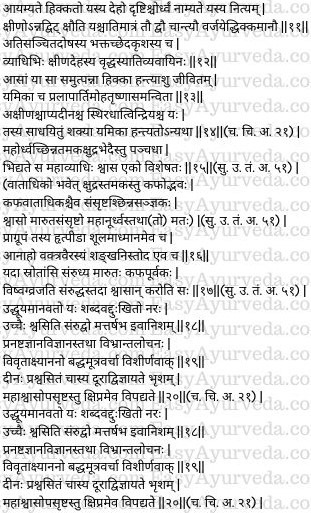
Read – Shwasa Roga Chikitsa: Ayurvedic Treatment, Medicines
Symptoms of Urdhva Swasa
The person suffering from Urdhva Swasa will have long expiration (breathes out for a longer duration) but will be unable to breathe in (inspiration) easily.
The mouth and other passages will be filled up with sputum. The other symptoms will be produced by vata which has undergone severe aggravation.
The person looks with an upward gaze i.e., the eyes are fixed up. The eyeballs roll in different directions. He will faint repeatedly and suffers from pain. There is whitish discoloration of the face and the patient will get restless.
The expiration gets deep and exacerbated while the inspiration gets obstructed. Due to this the person gets repeatedly restless and experiences loss of consciousness. These are the features of Urdhva Swasa and this also kills the patient. (21-23)
Read – Sanjnasthapana Gana – Consciousness Restoring Herbs Review, Benefits
Symptoms of Chinna Swasa
Chinna means interrupted or broken. In Chinna Swasa the respiration (breathing pattern) is often interrupted in the middle. It takes immense effort for the person to breathe in this condition. In spite of all efforts the person is in distress because he breathes with interruptions. In this condition there will be severe pain in all the vital organs. Due to this pain the person will not be capable of breathing properly. Also, due to fear of the pain getting worsened, the person would not attempt at respiration.
The person also would suffer from abdominal distension (flatulence), perspiration and fainting (loss of consciousness), burning sensation in the urinary bladder, eyes filled with tears, emaciation, redness of one eye, loss of consciousness, dryness of the mouth, discolouration and delirium. These are the symptoms of Chinna Swasa. This condition also kills the patient in a quick time. (24-26)
Read – 31 Easy And Effective Home Remedies For Dyspnoea
Pathogenesis, Symptoms of Tamaka Swasa
Pathogenesis – The aggravated vata moves in the opposite direction i.e., upwards and enters the channels of transportation of prana (vital air). On reaching these passages vata grasps the head and neck and further aggravates the kapha therein. On aggravating the kapha and finding its association, vata (along with kapha) causes pinasa (running nose). The movements of vata are also blocked by kapha. This vata which is obstructed by kapha (in the respiratory passages) will produce bubbling sounds in the throat. This ultimately produces severe bouts of increased respirations (in number and intensity) which pose a threat to life. This condition is called Tamaka Swasa.
Symptoms
- The person suffers from darkness in front of the eyes (feels as if he is surrounded by darkness), severe thirst, and becomes motionless.
- The person loses consciousness and faints as an effect of continuous bouts of cough.
- The patient remains restless and worried until the sputum is expelled. He keeps trying hard to expel that sputum by coughing repeatedly. When due to repeated coughing the sputum gets expelled, the person finds momentary relief.
- He would experience itching (obstruction) in the throat. He would be able to speak with great difficulty while putting constant effort. He will not be able to sleep when he lies down due to severe catching of breath (dyspnoea). This is also because the vayu (located in the flanks) creates severe pain in the flanks when he sleeps. He finds comfort when he comes back to sitting posture. (This is the only posture in which he finds relief).
- He desires hot / warm comforts and when given he finds relief.
- His eyes are wide open (swelling of eyes, upward gaze), there is sweating on the forehead and severe pain (in the chest).
- There is dryness of the mouth.
- He breathes in repeatedly and later breathes out putting all efforts and straining all his body parts with great difficulty and sounds.
- The symptoms get increased during cloudy days, by use of cold water, getting exposed to the breeze flowing from the east and other kapha aggravating causative factors.
- These are the symptoms of tamaka swasa. The disease is said to be yapya i.e., manageable (persists throughout life in spite of administering suitable treatment). This condition might also get cured if it is of very recent onset. (27-34)
Read – Shwasahara Gana – Anti Asthmatic Herbs Of Charaka
Pratamaka Swasa
When this disease i.e., tamaka swasa manifests along with fever and fainting (loss of consciousness), it will be called as Pratamaka Swasa.
Causes – Pratamaka Swasa is caused by –
- Upward movement of vata in many channels (abdomen – alimentary tract) / reverse peristalsis,
- Inhalation / exposure to dust
- Indigestion (indigested foods, ama etc)
- Increase of wetness or dampness of the body / excessive consumption of foods soaked in water
- Suppression of urges of the body (35)
Santamaka Swasa
When Tamaka Swasa is caused or gets increased (triggered) by tamas (darkness, contaminant of mind, inactivity, cloudy weather etc), makes the patient to go into a zone of darkness (the person feels as if he is entering into darkness or surrounded by darkness) and the symptoms get quickly subsided (patient gets comfort) by use of cold things, it is called as Santamaka Swasa. (36)
Read – Ayurvedic Liquid Remedies In The Management of Shwasa, Dyspnoea
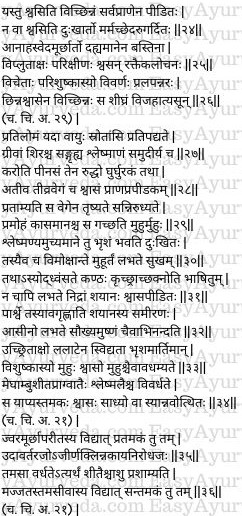
Symptoms of Kshudra Swasa
Causes – Kshudra Swasa is caused due to consumption of dry foods and physical exertion.
Vata getting aggravated by above said etiological factors moves upwards and causes difficulty in respiration. Kshudra means less. Since this condition is caused by less causative factors and has less symptoms (of lesser strength and severity) it is called as kshudra swasa.
Symptoms – The symptoms and bouts are mild in nature. It does not trouble the patient like other kinds of swasa (explained above). It doesn’t pose a threat to the life of the patient.
This swasa doesn’t cause any obstruction in the passage of food and respiration (the person can swallow food and water easily). It doesn’t interfere with the functioning of the sense organs (the power of perception of sense organs remains intact, and is not disturbed). It doesn’t produce any other disease or pain in the form of complications.
Kshudra Swasa is curable.
The other kinds of swasa are curable when they manifest in strong persons and when the symptoms manifest in an unclear / incomplete way (are mild or when in earlier stages of manifestation). (37-39)
Read – Home Remedy For Hiccups, Ashtma And Chronic Lung Diseases
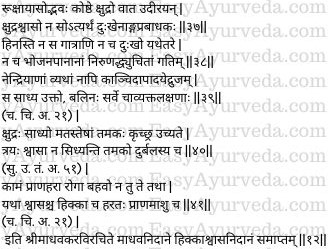
Prognosis of Swasa
Kshudra Swasa is curable. Tamaka Swasa is difficult to treat. The other three types of swasa are incurable. Tamaka Swasa occurring in weak persons is incurable. (40)
Dangerous nature of Swasa and Hikka
There are many dreadful diseases which take away life, but no disease is as quick as swasa and hikka in taking away the life of the patients. (41)
Thus ends the chapter on Śwāsa-hikkā Nidanam in Madhava Nidana text written by Acharya Madhavakara.










